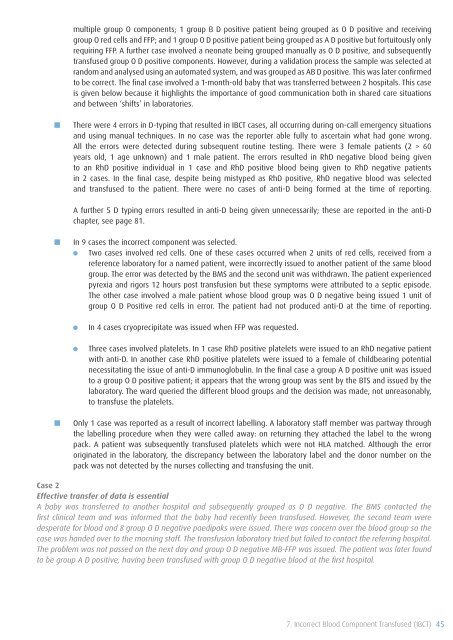SHOT Annual Report 2009 - Serious Hazards of Transfusion
SHOT Annual Report 2009 - Serious Hazards of Transfusion
SHOT Annual Report 2009 - Serious Hazards of Transfusion
Create successful ePaper yourself
Turn your PDF publications into a flip-book with our unique Google optimized e-Paper software.
multiple group O components; 1 group B D positive patient being grouped as O D positive and receiving<br />
group O red cells and FFP; and 1 group O D positive patient being grouped as A D positive but fortuitously only<br />
requiring FFP. A further case involved a neonate being grouped manually as O D positive, and subsequently<br />
transfused group O D positive components. However, during a validation process the sample was selected at<br />
random and analysed using an automated system, and was grouped as AB D positive. This was later confirmed<br />
to be correct. The final case involved a 1-month-old baby that was transferred between 2 hospitals. This case<br />
is given below because it highlights the importance <strong>of</strong> good communication both in shared care situations<br />
and between ‘shifts’ in laboratories.<br />
■■<br />
There were 4 errors in D-typing that resulted in IBCT cases, all occurring during on-call emergency situations<br />
and using manual techniques. In no case was the reporter able fully to ascertain what had gone wrong.<br />
All the errors were detected during subsequent routine testing. There were 3 female patients (2 > 60<br />
years old, 1 age unknown) and 1 male patient. The errors resulted in RhD negative blood being given<br />
to an RhD positive individual in 1 case and RhD positive blood being given to RhD negative patients<br />
in 2 cases. In the final case, despite being mistyped as RhD positive, RhD negative blood was selected<br />
and transfused to the patient. There were no cases <strong>of</strong> anti-D being formed at the time <strong>of</strong> reporting.<br />
A further 5 D typing errors resulted in anti-D being given unnecessarily; these are reported in the anti-D<br />
chapter, see page 81.<br />
■■<br />
In 9 cases the incorrect component was selected.<br />
Two cases involved red cells. One <strong>of</strong> these cases occurred when 2 units <strong>of</strong> red cells, received from a<br />
reference laboratory for a named patient, were incorrectly issued to another patient <strong>of</strong> the same blood<br />
group. The error was detected by the BMS and the second unit was withdrawn. The patient experienced<br />
pyrexia and rigors 12 hours post transfusion but these symptoms were attributed to a septic episode.<br />
The other case involved a male patient whose blood group was O D negative being issued 1 unit <strong>of</strong><br />
group O D Positive red cells in error. The patient had not produced anti-D at the time <strong>of</strong> reporting.<br />
In 4 cases cryoprecipitate was issued when FFP was requested.<br />
Three cases involved platelets. In 1 case RhD positive platelets were issued to an RhD negative patient<br />
with anti-D. In another case RhD positive platelets were issued to a female <strong>of</strong> childbearing potential<br />
necessitating the issue <strong>of</strong> anti-D immunoglobulin. In the final case a group A D positive unit was issued<br />
to a group O D positive patient; it appears that the wrong group was sent by the BTS and issued by the<br />
laboratory. The ward queried the different blood groups and the decision was made, not unreasonably,<br />
to transfuse the platelets.<br />
■■<br />
Only 1 case was reported as a result <strong>of</strong> incorrect labelling. A laboratory staff member was partway through<br />
the labelling procedure when they were called away: on returning they attached the label to the wrong<br />
pack. A patient was subsequently transfused platelets which were not HLA matched. Although the error<br />
originated in the laboratory, the discrepancy between the laboratory label and the donor number on the<br />
pack was not detected by the nurses collecting and transfusing the unit.<br />
Case 2<br />
Effective transfer <strong>of</strong> data is essential<br />
A baby was transferred to another hospital and subsequently grouped as O D negative. The BMS contacted the<br />
first clinical team and was informed that the baby had recently been transfused. However, the second team were<br />
desperate for blood and 8 group O D negative paedipaks were issued. There was concern over the blood group so the<br />
case was handed over to the morning staff. The transfusion laboratory tried but failed to contact the referring hospital.<br />
The problem was not passed on the next day and group O D negative MB-FFP was issued. The patient was later found<br />
to be group A D positive, having been transfused with group O D negative blood at the first hospital.<br />
7. Incorrect Blood Component Transfused (IBCT) 45












